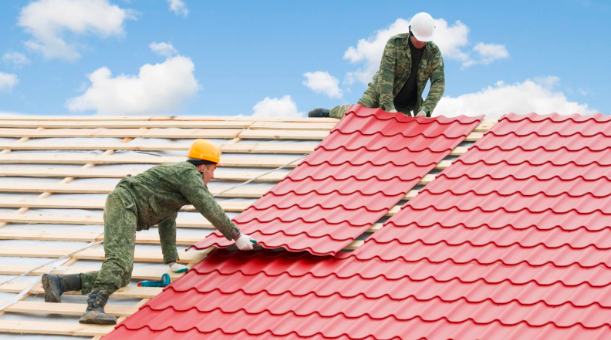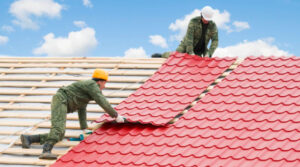How to Prepare Your Home for Roofing Installation

 Roofing installation is a major home improvement project. Before roofing professionals arrive, remove wall decor: The vibrations of hammering can knock decorations down and damage other items. Roll-out underlayment, a felt material that prevents ice dams and heavy rain from seeping into your home. This self-sticking material is rolled out flat, straight over the deck, and nailed down every couple of feet.
Roofing installation is a major home improvement project. Before roofing professionals arrive, remove wall decor: The vibrations of hammering can knock decorations down and damage other items. Roll-out underlayment, a felt material that prevents ice dams and heavy rain from seeping into your home. This self-sticking material is rolled out flat, straight over the deck, and nailed down every couple of feet.
A new roof is a major homeowner project requiring proper preparation. This preparation is not only for the protection of the home but also for the safety of those who work on the roof. The preparation process includes the following steps:
Remove items from outside your home. This is important because it protects your belongings from falling debris and helps keep the area clear for a smoother installation process. This includes moving children’s toys, bikes, patio furniture, and other outdoor items. It is also important to clear the yard to avoid tripping hazards. You should also cover plants and lawn ornaments with tarps to protect them from nails and other debris.
If you have a pool, you should also cover it with a tarp. This is to prevent splinters and other debris from getting into the water. You should also make sure that you have access to your power outlets, as the roofers will need them to run their equipment. It is also a good idea to move any cars, boats, or other exterior furniture away from the home, as this will allow for easier movement of materials and vehicles.
The roofers will be throwing shingles everywhere, and this can damage your yard and landscaping. It is a good idea to put down tarps in the garden and yard to catch the trash. It is also a good idea to cover your driveway with a tarp or plywood. This will keep debris and mud from tracking into your house.
You should also remove any wall hangings or other items from the walls before roofing starts. The vibrations caused by the hammering can knock them off, so it is best to take them down beforehand. You should also relocate other fragile items, such as china plates or vases.
If you have pets or small children, it is a good idea to bring them inside during the roof replacement. This will protect them from the dust and noise of the construction. It is also a good idea to prepare your kids and explain what will happen during the process. This will help them understand the importance of being careful during the roof replacement and will make them less anxious about the noise and chaos.
Materials
A top-tier roofer will use the right materials to ensure your home is well protected. First, there’s the sheathing — a wood foundation that holds shingles and other roofing materials in place. This may be plywood or OSB and is critical to the structural integrity of your home.
Next comes the underlayment — a layer of water-resistant felt paper that goes over the sheathing. It’s designed to prevent water from seeping into the structure of your home and also helps protect against mold, mildew, fungus and other harmful organisms.
Once the underlayment is in place, it’s time to add your chosen roof covering. The shingle or other material you choose will have its own specific requirements. Wood shingles and shakes are classic choices, offering a rustic look that adds value to your home. Metal options such as copper and galvanized steel last up to 75 or 100 years. These are expensive materials, but their upfront cost is offset by their longevity.
Then you have your ventilation system, which must be properly installed to prevent moisture build-up in the attic and ice damming. Vents are essential to keep your attic cool, while allowing equal amounts of air to go in and out.
You’ll also need flashing, which is metal material that’s placed around chimneys, joints and other vulnerable spots to keep water from leaking in. A quality contractor will use high-grade flashing to protect your roof from leaks.
Finally, you need insulation to help your roof stay cooler in the summer and warmer in the winter. A good contractor will install insulation correctly to maximize its effectiveness.
There are several types of roofing materials, including rolled roofing, which is inexpensive and easy to install. It’s best for roofs with a lower incline and can be hammered into place. You can also choose a shingle-like option, which is much more durable and looks like slate or wood. Some homeowners prefer rubber roofing, which has the added benefit of being eco-friendly and long-lasting. If you’re looking to go even greener, you can select solar shingles, which generate electricity from renewable resources and add value to your home.
Installation
Roof installation can be a daunting project. It requires a lot of physical labor and it can be dangerous, especially for people who are afraid of heights or are not very fit. For these reasons, roofing is usually something that homeowners want to hire a professional for. However, there are some types of roofs that can be successfully installed by a team of savvy DIY’ers with the right knowledge and tools.
The first step of the process is to lay a breathable underlay support tray, ensuring it is properly secured. Next, the ridge batten is fixed to one end of the roof and then the ridge tiles are laid. A ridge-to-ridge seal is then installed to offer a mechanical fix and extra strength to the ridge.
It is important to note that re-roofing with new shingles can require a permit, especially if the sheathing is being removed. It is also a good idea to cover any plants with plastic sheeting and have a roll-off dumpster parked nearby so that old shingles can be thrown directly into it.
Maintenance
Roof maintenance includes surface cleaning, re-caulking, and repair of minor leaks and punctures. This type of work should only be done by a professional who is familiar with the roofing materials and roofing installation methods used on your roof. It is also a good idea to avoid trying this work yourself, especially on a steep-sloped roof or one made of metal, which can be slippery when wet. Attempting to perform roof maintenance can lead to serious injuries, including falls from ladders, and can void the warranty on your new roofing system.
The first step in roof maintenance is to clear away any debris from the roof surface. Then the roofer will inspect the flashing, which is material like aluminum or galvanized steel that’s installed over the joints on the roof to prevent water seepage. This will be checked particularly around vents, chimneys and skylights. If there’s evidence of leaking, the roofer will add more flashing to the area and seal it properly.
Next, a roofer will look for any areas where the shingles appear dirty, dusty or stained. They will clean these areas using a gentle wash, and rinse with water to help reduce the risk of mildew formation. Depending on the weather and the location of the building, this may be done as often as once or twice per year.
In addition, the roofer will check that any gutters and leaders are secure, and that all tarps and other covers are in place. They’ll also trim any trees and organic growth that hang over the roof, to prevent them from catching on the shingles and causing damage. They’ll also make sure that all penetrations are properly sealed and re-flash any openings in the roof penetration base flashing.

